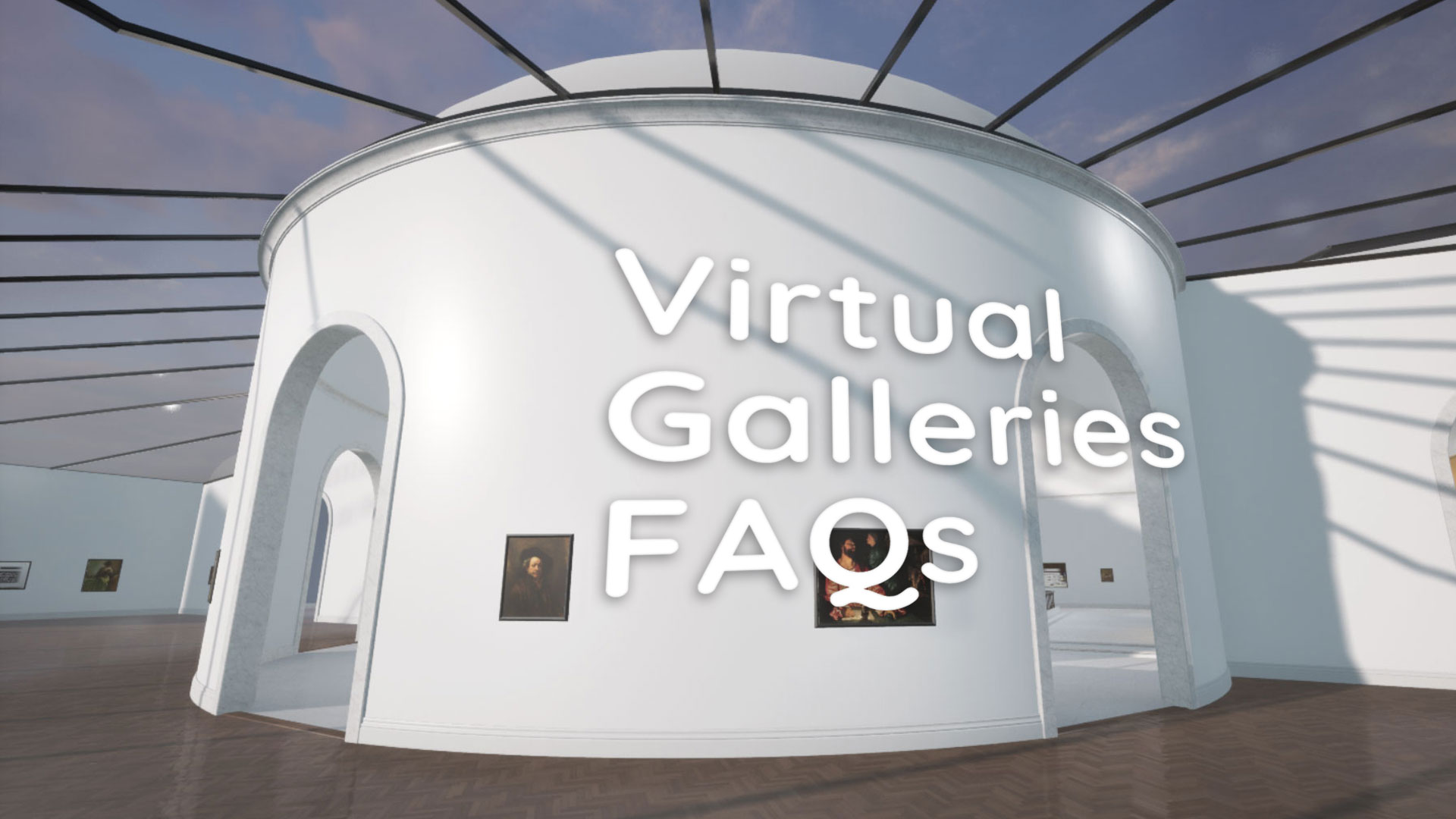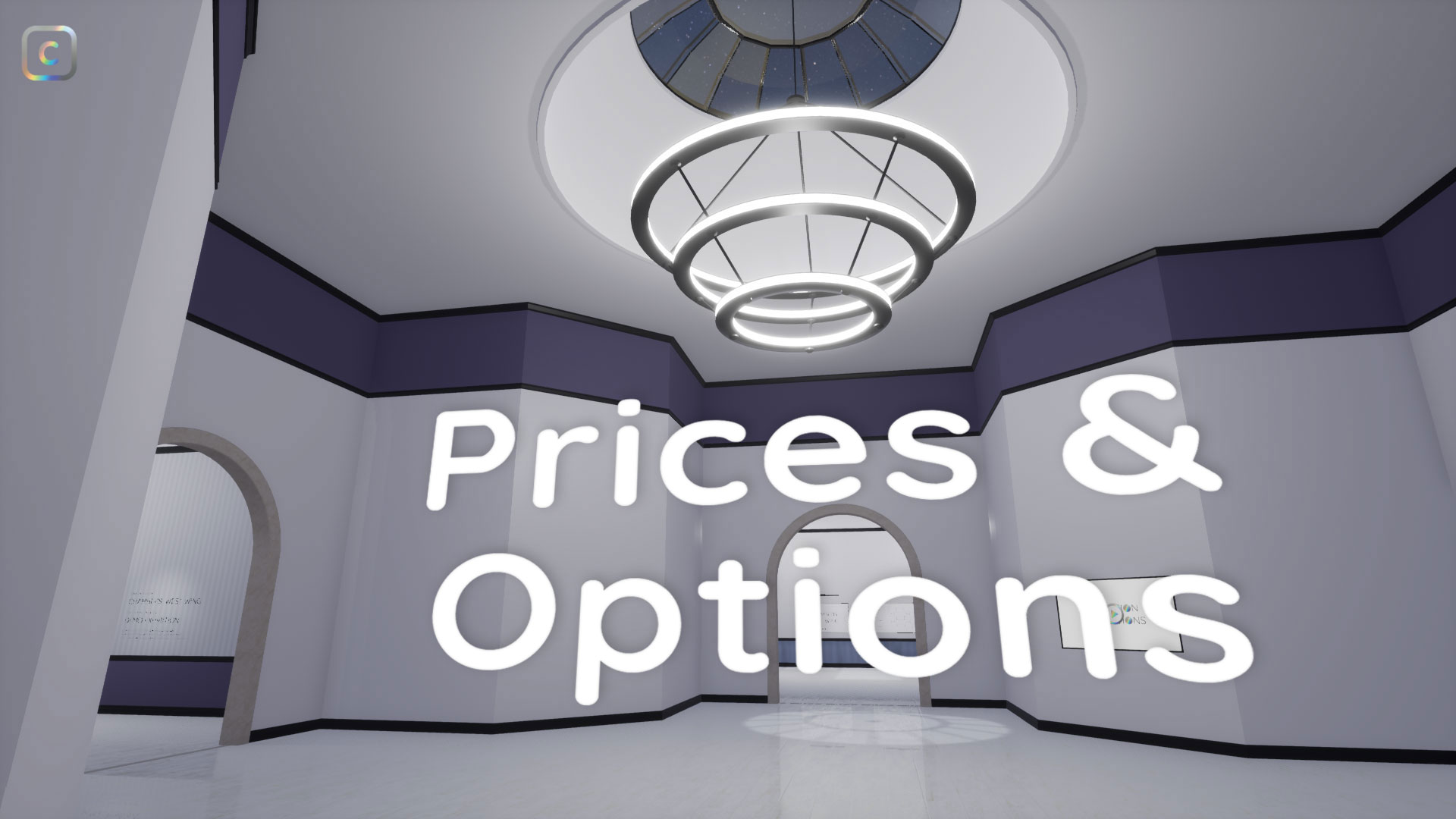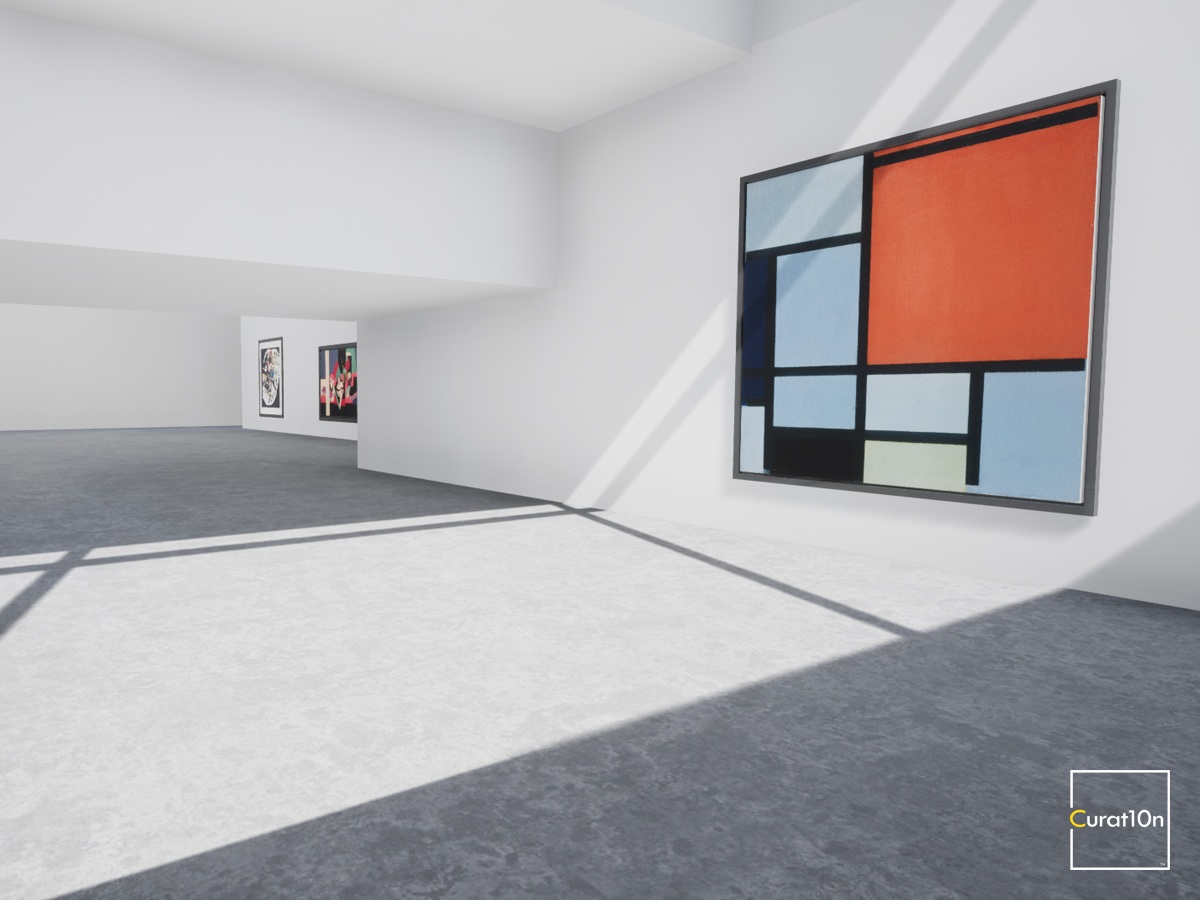Exhibition Design FAQs
This page gives answers to Frequently Asked Questions about different types of exhibition content and the process of curating, designing and organizing a virtual exhibition. It also answers questions about how you can work with us in consultation, or how you can manage your own virtual gallery usin gthe Gallery Management System (GMS).
- Your Exhibition Content
- Curating and Designing an Exhibition
- Exhibition Design Consultation
- The Gallery Managment System
Go to the Virtual Gallery FAQ page if you have questions about the Curation Exhibitions platform, virtual gallery spaces and how you can share your gallery with visitors.
1. Your Exhibition Content – FAQs
Can you edit my images before they are displayed in the exhibition?
Yes. We can edit your images and get them ready before adding them to your content archive and your virtual gallery.
Basic image editing is £3 per image and includes adjustments to image contrast, colour saturation, and making corrections for poor lighting.
Standard image editing is £6 per image. This also includes cropping, rotation and squaring images that have been taken from an angle. We can also crop out picture frames and surrounding walls. This is useful if you have taken photographs and the images are not perfectly horizontal or parallel to the camera, or if your photographs show the surrounding walls and environment.
Advanced image editing and graphic design are also available. This would involve adding or designing new elements. It is useful for making decal text that can be put on the walls of your virtual gallery, or for making new branding. The cost of this will depend on your request.
If you use our image editing services we will send you a copy of all the newly edited images. These will be your copyright property and can be used for any other projects you wish.
How can I turn sculptures and other exhibits into 3D models?
If you have a sculpture or other 3-dimensional object and you want to put this in a virtual gallery, there are a few options.
The only way to create a truly 3D model is by scanning the object. There are two techniques for doing this: Photogrammetry or laser scanning.
Photogrammetry uses a large number of photographs to generate a 3D model. You will need to photograph your object from many angles, and in a well-lit room. These photographs are then processed digitally to make the 3D model. We provide this service and will give you instructions on how to set up your object and take photographs. Please contact us if you would like to do this. The cost of this service starts at £90 per object. The results can vary in quality depending on the object that is being scanned. Please note that this may not be appropriate for objects with fine details, or for objects that are transparent or highly reflective.
Laser scanning requires the use of a hand-held scanner. We can provide instructions and help you to hire one of these scanners in your local area. We can also provide support when using the scanner. This is more economical if you want to produce many 3D models and you can hire a scanner for a short period of time.
There are other options for showing 3D objects in a virtual gallery. These are easier, quicker and lower cost, but they would not be considered as truly 3D. We call this “2.5D” as it uses regular photographs to give the illusion of a 3D object in a virtual gallery. One of these 2.5D objects can be added to your virtual gallery from as little as £20.
Can I put text, branding and other images on the walls of the gallery? Do they have to be on a canvas or in a frame?
Yes, you can put any type of image in a virtual gallery.
Images do not need to be displayed on a canvas or in a frame. Images can be placed directly onto walls so they look like decals, posters or stickers. Images can also use transparency.
What types of image files can be added to a virtual exhibition?
Almost any image format can be used.
You can send your images to us and we will add them to your content archive. We will optimise and re-format all images before adding them to your archive. This is free of charge, and it will ensure that images load as fast as possible without any visible loss of image quality.
If you are adding images yourself directly (using the Gallery Management System), these images should be in JPG, PNG or BMP format.
What types of multimedia files can be added to a virtual gallery?
Images, videos, audio recordings and 3D models can be added to a virtual gallery.
Almost all common file formats can be used for images, videos and audio. We will re-format media files for you, free of charge, before adding them to your content archive.
3D models should be exported as OBJ, FBX or Blend files.
What types of 3D models can be added to a virtual gallery?
Before adding a 3D model to your content archive and virtual gallery, we will first check its quality and formatting. You should export your 3D models in OBJ, FBX or Blend format before sending these to us.
In most cases, materials will be discarded from the 3D model file. This is due to inconsistency in quality and setup. If you would like to use custom materials for a 3D model, please speak to us about this first to see whether it is possible. You will be able to select new materials to apply to your 3D model, making use of our own materials library.
3D models should not include skeletal rigging or bones, and should not include animation. If you would like to add a 3D model with animation, please speak to us first about whether this is possible.
How can artists and curators be credited?
Every exhibit in a virtual gallery can have information shown alongside it. This information will be shown on-screen when visitors look at an exhibit.
Basic information such as the name of the artist/creator and the title of the piece is shown on-screen as visitors look around the gallery.
Visitors can interact with exhibits to see more information about each piece. You can add descriptions, dates, prices, and any other text information that you wish. Each exhibit can also have one or two web links, allowing visitors to go to an external web page. This is useful for integrating your virtual exhibition with an online store, or for connecting people with social media accounts, web sites, or any other online resource.
Can I show videos?
Videos can be placed in a virtual gallery in the same way as images. They can be displayed on a screen attached to the wall, or they can be displayed directly on the wall (like a projection).
It is also possible to show videos on curved surfaces or irregularly shaped surfaces. They can be shown at any scale.
Can I add music or other audio recordings?
Yes.
Audio recordings can be played when entering a new virtual gallery, or when interacting with any exhibit.
When entering a new gallery you can use this feature to play an introduction to the exhibition, such as a recording by the curator or artists. This feature can also be used to start playing a piece and to create a soundtrack while visitors explore the gallery.
If you have audio recordings that are the focus of your exhibition, these can be “attached” to a 3D audio player. The audio will start to play when a visitor interacts with the 3D audio player. For example, you can add a wall-mounted speaker, a speaker on a plinth, or a DJ turntable to your gallery and these will be the focal point for your audio.
Audio recordings can also be played when a visitor interacts with an exhibit. This means that you could add an audio description to any picture or 3D object in your exhibition.
It is possible to have two audio recordings playing at the same time. This means that a piece of music can continue playing in the background, while an audio guide or spoken word piece plays over the top.
Can you edit videos and audio recordings for me before adding them to an exhibition?
Yes. We can provide basic video and audio editing.
Basic video editing would include cutting sections of a video. For example, you may wish to only use a small section of a longer video, or you may want to remove the intro or outdo section of a video.
We can also add subtitles to videos.
Basic audio editing would also include cutting sections of an audio recording. We can also adjust the amplitude (volume) of your audio recording if it is too quiet, or if it is too loud (and becoming distorted).
We can also provide advice on how to record good-quality audio for your virtual exhibition.
2. Curating and Designing an Exhibition – FAQs
Can I make several versions of an exhibition before choosing which one to show to visitors?
Yes.
This will work differently depending on whether you are working in consultation with us, or if you are using the Gallery Management System (GMS).
When an exhibition is being made we will regularly save it at each stage of its design. We can also create multiple versions of the same gallery so that you can easily explore each version and compare them.
Is it possible for several people to design an exhibition together? Would this work if they are in different locations?
This will work differently depending on whether you are working with us in consultation or using the online Gallery Management System (GMS).
If you are working in consultation with us then we can arrange group video calls during the design process. This will allow many people to see how the gallery and exhibition are developing, and to also give their feedback. We can also send video recordings and images for your to share and discuss (if a video call is not possible). You will be able to make decisions and generate feedback as a team before making changes to the design brief and telling us what changes you would like to see.
If you are using the GMS then you and your team will have access to an online link. This link will take you and your team to a single page where you can organise and update your exhibition. Multiple people can work on this at the same time and from any location. It is up to you to manage your own team and decide who make changes via the GMS. It is possible for you to save and re-load different exhibition designs throughout the design process, so you can try out different things.
What is the process for choosing an artwork, choosing where to put it, and choosing how it is displayed?
The first step is to choose a position for the new exhibit and then choose an exhibit from your content archive. Your content archive is a list of all your images, videos, audio recordings and 3D models.
After you have added an exhibit you can change the way it is displayed. For images, you can choose the type of canvas and frame. For videos, you can choose the type of screen. For 3D models, you can choose to add a plinth or display stand.
You can then add a light to the exhibit. If your exhibit is placed on the wall you can add a light fixture above it, or you can add an invisible spotlight.
There are several other adjustments you can make, including:
- Changing the overall scale of the exhibit
- Adjusting the position of the exhibit on the wall or floor
- Rotating the exhibit
- Attaching further information to the exhibit, such as titles, descriptions and web links
What options do I have for displaying an artwork? How many types of frames can I choose from?
There are more than 20 frame styles available as standard. These include various frame colours and materials such as wood, paint and metal. There are also different frames widths, both with and without an internal mount/border.
If you have a PRO or PREMIUM subscription, or if you are working with us in consultation, any number of extra frames and display styles can be added. You will be able to choose any combination of frame profiles, materials, frame sizes and colours. There are thousands of possible combinations and you will be able to use these for any images of videos in your virtual gallery.
3. Exhibition Design Consultation – FAQs
What do you mean by “Design Consultation”? How does it work?
We will work with you to design your virtual gallery and make decisions about your virtual exhibition.
It is up to you how much you want to be involved in the design process. Some of our clients prefer to give us a set of instructions (a design brief) and then expect us to produce the whole exhibition. Other clients prefer to meet with us several times throughout the process and to give feedback and new instructions at each stage.
We can meet with you to discuss the virtual exhibition and make changes during a video call. Alternatively, we can send you an unfinished version of the exhibition for you to look at and then come back to us with your feedback.
Design consultation gives you control over the design of your exhibition, but it also makes full use of our design expertise. There is no need for you to use any software during the design process (except for communication) and we can help to streamline the design process.
I want to promote my virtual exhibition before it is finished? Can you produce a "teaser" video or send me some screenshots?
Yes.
It can take time to design and make a new virtual gallery or exhibition, especially if you are working in consultation with us to create something original.
During the design process we can record a video tour of your virtual gallery, even if it is not yet finished. You can use this to show people how development is going, or you can use it to promote your virtual gallery before it is released.
If you are working with us to create a new virtual gallery space, the best way to make decisions is via video call. We can then show you the gallery at each stage of its development. We can also share screenshots, design drawings and video recordings at any point in the design process.
Do I need to have any computer skills to make a virtual exhibition?
You won’t need to learn any new skills to work with us and make a virtual exhibition. If you are able to use email, and share files with others, then these are the only skills you need. We can do everything else.
Can you work in consultation with a large group of people? I am part of a group and we all want to have an input.
If you are working in consultation with us then we can arrange group video calls during the design process. This will allow many people to see how the gallery and exhibition are developing, and to also give their feedback. We can also send video recordings and images for your to share and discuss (if a video call is not possible). You will be able to make decisions and generate feedback as a team before making changes to the design brief and telling us what changes you would like to see.
4. Gallery Management System – FAQs
Virtual Galleries FAQs
Go to the Virtual Gallery FAQ page if you have questions about the Curation Exhibitions platform, virtual gallery spaces and how you can share your gallery with visitors.



